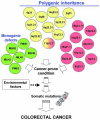Beyond genome-wide association studies: genetic heterogeneity and individual predisposition to cancer
- PMID: 20106545
- PMCID: PMC2826571
- DOI: 10.1016/j.tig.2009.12.008
Beyond genome-wide association studies: genetic heterogeneity and individual predisposition to cancer
Abstract
Genome-wide association studies (GWAS) using population-based designs have identified many genetic loci associated with risk of a range of complex diseases including cancer; however, each locus exerts a very small effect and most heritability remains unexplained. Family-based pedigree studies have also suggested tentative loci linked to increased cancer risk, often characterized by pedigree-specificity. However, comparison between the results of population- and family-based studies shows little concordance. Explanations for this unidentified genetic 'dark matter' of cancer include phenotype ascertainment issues, limited power, gene-gene and gene-environment interactions, population heterogeneity, parent-of-origin-specific effects, and rare and unexplored variants. Many of these reasons converge towards the concept of genetic heterogeneity that might implicate hundreds of genetic variants in regulating cancer risk. Dissecting the dark matter is a challenging task. Further insights can be gained from both population association and pedigree studies.
Copyright 2009 Elsevier Ltd. All rights reserved.
Figures


Similar articles
-
Family Study Designs Informed by Tumor Heterogeneity and Multi-Cancer Pleiotropies: The Power of the Utah Population Database.Cancer Epidemiol Biomarkers Prev. 2020 Apr;29(4):807-815. doi: 10.1158/1055-9965.EPI-19-0912. Epub 2020 Feb 25. Cancer Epidemiol Biomarkers Prev. 2020. PMID: 32098891 Free PMC article.
-
Genome-wide linkage and association analysis of primary open-angle glaucoma endophenotypes in the Norfolk Island isolate.Mol Vis. 2017 Sep 28;23:660-665. eCollection 2017. Mol Vis. 2017. PMID: 28966548 Free PMC article.
-
Design considerations for genetic linkage and association studies.Methods Mol Biol. 2012;850:237-62. doi: 10.1007/978-1-61779-555-8_13. Methods Mol Biol. 2012. PMID: 22307702
-
Genome-wide association studies of cancer predisposition.Hematol Oncol Clin North Am. 2010 Oct;24(5):973-96. doi: 10.1016/j.hoc.2010.06.009. Hematol Oncol Clin North Am. 2010. PMID: 20816582 Review.
-
Genetics of Multiple Sclerosis: An Overview and New Directions.Cold Spring Harb Perspect Med. 2018 Jul 2;8(7):a028951. doi: 10.1101/cshperspect.a028951. Cold Spring Harb Perspect Med. 2018. PMID: 29440325 Free PMC article. Review.
Cited by
-
A pri-miR-218 variant and risk of cervical carcinoma in Chinese women.BMC Cancer. 2013 Jan 15;13:19. doi: 10.1186/1471-2407-13-19. BMC Cancer. 2013. PMID: 23320911 Free PMC article.
-
Genomic Regions Associated with IgE Levels against Culicoides spp. Antigens in Three Horse Breeds.Genes (Basel). 2019 Aug 8;10(8):597. doi: 10.3390/genes10080597. Genes (Basel). 2019. PMID: 31398914 Free PMC article.
-
Regularized machine learning in the genetic prediction of complex traits.PLoS Genet. 2014 Nov 13;10(11):e1004754. doi: 10.1371/journal.pgen.1004754. eCollection 2014 Nov. PLoS Genet. 2014. PMID: 25393026 Free PMC article. No abstract available.
-
Rapid dissemination of RET-transgene-driven melanoma in the presence of non-obese diabetic alleles: Critical roles of Dectin-1 and Nitric-oxide synthase type 2.Oncoimmunology. 2015 Oct 29;5(5):e1100793. doi: 10.1080/2162402X.2015.1100793. eCollection 2016 May. Oncoimmunology. 2015. PMID: 27467912 Free PMC article.
-
Special considerations in prognostic research in cancer involving genetic polymorphisms.BMC Med. 2013 Jun 17;11:149. doi: 10.1186/1741-7015-11-149. BMC Med. 2013. PMID: 23773794 Free PMC article. Review.
References
-
- Lichtenstein P, et al. Environmental and heritable factors in the causation of cancer--analyses of cohorts of twins from Sweden, Denmark, and Finland. N Engl J Med. 2000;343:78–85. - PubMed
-
- Czene K, et al. Environmental and heritable causes of cancer among 9.6 million individuals in the Swedish Family-Cancer Database. Int J Cancer. 2002;99:260–266. - PubMed
-
- Borecki IB, Province MA. Linkage and association: basic concepts. Adv Genet. 2008;60:51–74. - PubMed
-
- Weedon MN, Frayling TM. Reaching new heights: insights into the genetics of human stature. Trends Genet. 2008;24:595–603. - PubMed
Publication types
MeSH terms
Grants and funding
LinkOut - more resources
Full Text Sources
Other Literature Sources

